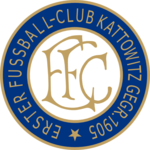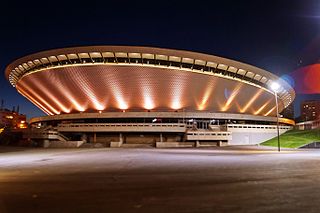
Katowice is the capital city of the Silesian Voivodeship in southern Poland and the central city of the Katowice urban area. As of 2021, Katowice has an official population of 286,960, and a resident population estimate of around 315,000. Katowice is a central part of the Metropolis GZM, with a population of 2.3 million, and a part of a larger Katowice-Ostrava metropolitan area that extends into the Czech Republic and has a population of around 5 million people, making it one of the most populous metropolitan areas in the European Union.

Ernest Otton Wilimowski, nicknamed "Ezi", was a footballer who played as a forward. He ranks among the best goalscorers in the history of both the Poland national team and Polish club football. After re-taking German citizenship following the invasion of Poland, he also played for the Germany national team.
Erwin Peter Nytz or Edward Piotr Nyc was a Polish footballer who played as a midfielder.
AKS Chorzów is a sports club based in Chorzów, Poland. It is one of the earliest sports organizations in Upper Silesia and is still well known nationally for its football and handball teams. The club also made its mark on the international stage: Halina Richter-Górecka was part of the gold medal-winning women's 100m relay team at the 1964 Tokyo Olympic Games; tennis player Danuta Wieczorek appeared at Wimbledon as a junior.

SV Blitz Breslau was a German football club playing in Breslau, Lower Silesia in what was then part of Germany but is today Wrocław, Poland. The club was established on 1 April 1897 by former members of the cycling club Radverein Blitz Breslau. SVB was one of the founding members of the German Football Association established in Leipzig in 1900.
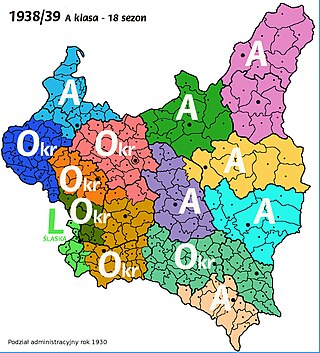
In the Second Polish Republic, there was not a national, Second Division, as we know it today, although the creation of the second division was proposed on several occasions. On Sunday, 26 September 1937 in Częstochowa, a conference of regional teams from across the nation took place, to discuss the creation of the league. Officials of several clubs arrived, such as Brygada Częstochowa, Gryf Toruń, Śmigły Wilno, Rewera Stanisławów, Dąb Katowice, Unia Sosnowiec, Strzelec Janowa Dolina, and WKS Grodno. Also, invited were officials of HCP Poznań, Podgorze Kraków, Naprzód Lipiny and Union Touring Łódź, but for unknown reasons they did not show up. The officials talked about creation of a National B-League, but nothing came out of this project. Instead, in the years 1921-1939, several Voivodeships held their own games and those leagues were known as A-Classes. In 1927, the elite Polish Football League was created, which by the late 1930s consisted of 10 teams. The teams that did not make it to the Ekstraklasa, played in the A-Classes.

The Gauliga Schlesien was the highest football league in the region of Silesia (German:Schlesien), which consisted of the Prussian provinces of Lower Silesia and Upper Silesia from 1933 to 1945. Shortly after the formation of the league, the Nazis reorganised the administrative regions in Germany, and the Gau Silesia, later subdivided into Gau Upper Silesia and Gau Lower Silesia, replaced the Prussian provinces.

SC Diana Kattowitz was an ethnically German association football club playing in what was Kattowitz, Upper Silesia in Germany during the inter-war period. Established 13 February 1905, it was one of a small number of clubs that made up the Kattowitzer Ballspiel-Verband alongside Preussen Kattowitz and Germania Kattowitz. With FC 1903 Ratibor, these clubs formed the Upper Silesian division of the Southeast German Football Federation in 1906.
Germania Kattowitz was an ethnically German association football club playing in what was Kattowitz, Upper Silesia in Germany before the First World War and shortly afterwards. It was one of a small number of clubs that made up the Kattowitzer Ballspiel-Verband alongside Preussen Kattowitz and Diana Kattowitz. With FC 1903 Ratibor, these clubs formed the Upper Silesian division of the Southeast German Football Federation in 1906.

Preußen Hindenburg was a German association football club from the village of Zaborze, Upper Silesia in Germany.
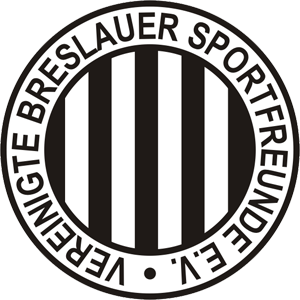
Vereinigte Breslauer Sportfreunde was a German association football club from what was at the time the city of Breslau, Lower Silesia in Germany and is today Wroclaw, Poland. The club was established in 1919 through the merger of predecessor sides SC Preußen Breslau and Verein Breslauer Sportfreunde. They dominated play in the regional Südostdeutschland league in the period immediately following World War I.

Askania Forst was a German association football club in what was the city of Forst (Lausitz), Brandenburg and is today Zasieki, Poland. Established in 1901, the team earned a number of championships in the 1910s, but disappeared from top flight German football after 1920.

SC Germania Breslau was a German association football club from the city of Breslau, Lower Silesia. The team spent several seasons in upper tier regional play in the Südostdeutscher Fußball-Verband and advanced to the league playoffs in 1911 and 1912.
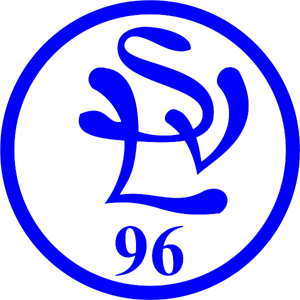
ATV Liegnitz was a German association football club from what was then the city of Liegnitz, Lower Silesia in Germany, but is today Legnica, Poland. The origins of the club were in the establishment of the gymnastics club Alter Turnverein Liegnitz in 1852, which formed a football department in July 1896.
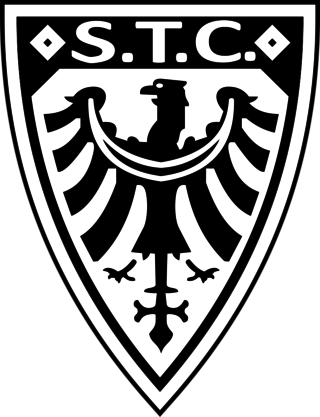
STC Görlitz was a German association football club from the city of Görlitz, Silesia. The club was established as Sportclub Preußen Görlitz in 1906.
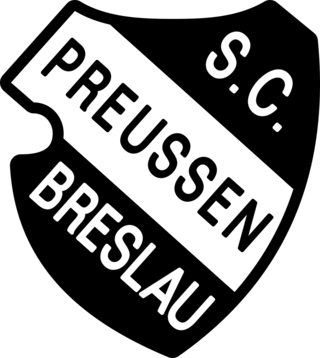
SC Preußen Breslau was a German association football club from the city of Breslau, Lower Silesia. The club was briefly part of the top flight regional Südostdeutscher Fußball-Verband in the early 1900s.

Breslauer SC was a German association football club from the city of Breslau, Lower Silesia. The club enjoyed its greatest successes in the late 1920s.
Kattowitz is the German name for the Polish city of Katowice.
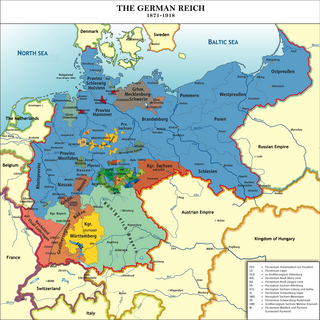
The South Eastern German football championship was the highest association football competition in the Prussian provinces of Silesia, which was divided into the Province of Lower Silesia and the Province of Upper Silesia after 1919, and Posen, which mostly became part of Poland in 1919. The competition was disbanded in 1933.

SC Preußen Stettin was a German association football club from the city of Stettin, Pomerania Province.
